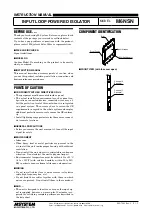
88
Overview
Once a system has been configured, it must be calibrated using the display unit installed in the cab.
If there are multiple junction boxes, each must be calibrated. For example; A truck and a trailer will
contain multiple junction boxes, one for the truck, one for the trailer.
Ensure all junction boxes are connected to the display unit before starting the calibration.
Ensure that you know the gross vehicle weight (GVW) before you calibrate the system
Two sets of vehicle measurements must be taken:
• Zero weights. This is the weight measurement of each axle when the vehicle has an empty payload
• Span weights. This is the weight measurements for each axle when the vehicle has a payload as close
to GVW as possible
The display unit will show a message to indicate the current stage of the configuration and calibration
process:
• Config required. This indicates that the vehicle has not yet been configured. See “Configuration” on
• Zero required. This indicates that the vehicle configuration is complete, but the zero process is
complete. See “Zero calibration” on page 92
• Span required. This indicates that the vehicle configuration is complete and the zero process is
complete, but the span process is not complete. See “Span calibration” on page 94
TruckWeigh
®
Summary of Contents for TruckWeigh
Page 1: ...vpgonboard com TruckWeigh Installation Setup and Calibration Manual...
Page 2: ...2 TruckWeigh...
Page 8: ...8 TruckWeigh...
Page 9: ...9 Installation TruckWeigh...
Page 15: ...15 Tractor Suzi Trailer Suzi Rigid Suzi TruckWeigh...
Page 41: ...41 Configuration TruckWeigh...
Page 87: ...87 Calibration TruckWeigh...
Page 98: ...98 TruckWeigh...
Page 99: ...99 System options TruckWeigh...
Page 114: ...114 TruckWeigh...
Page 115: ...115 Appendix A TruckWeigh...
Page 119: ...119 Appendix B TruckWeigh...
Page 122: ...122 TruckWeigh...
Page 123: ...123 Appendix C TruckWeigh...
Page 126: ...126 TruckWeigh...
Page 127: ...127 Appendix D TruckWeigh...
















































